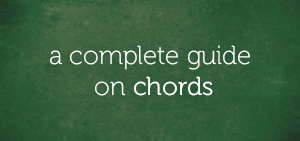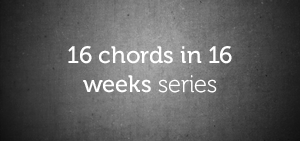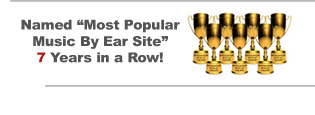If you listen to music, you’ve definitely heard a “2-5-1” progression. They are found in just about any type of music — regardless of style, genre, or rhythmical pattern. It is commonly the series of chords that end a song or phrase. However, it can be used in several situations (I can only go over a few in this lesson but encourage you to check out my course for further instruction).
In this chord progression, the 2 chord (you’ll learn what this is later on in this lesson) leads to the 5 chord which in turns, produces a strong pull towards the ending chord (which is usually the 1st major chord of the scale).
First, let me start by showing you what chords correspond to each tone of a major scale:
1 tone – Major
2 tone – Minor
3 tone – Minor
4 tone – Major
5 tone – Major (dominant)
6 tone – Minor
7 tone – Half Diminished
To understand the chart above, you must understand that each tone of a major scale has a chord which goes along with it. For example, the following is a C major scale:
(C — D — E — F — G — A — B — C)
Each tone above has a matching chord. Simply add the endings of the chart above to the scale as shown below:
>C MAJORD MINORE MINORF MAJORG MAJOR / DOMA MINORB HALF-DIMINISHED<
To further understand progressions, lets number each chord:
1 = C major
2 = D minor
3 = E minor
4 = F major
5 = G dominant
6 = A minor
7 = B half – diminished
8 = C major
Now, to create a “2-5-1” chord progression (or any numbered chord progression), simply take the 2, 5, and 1 chord out of the entire series of chords above. That is, we would not use the 3,4, 6, or 7 chord.
The 2 chord is D minor; the 5 chord is G dominant; and the 1 chord is C major.
This right here is the most basic “2-5-1” chord progression you’ll ever see:
Dmin — Gdom — Cmaj
min = minor
dom = dominant
maj = major
REFERENCE 1A:
D minor chord = (D) + (F) + (A)
G dominant chord = (G) + (B) + (D) + (F)
C major chord = (C) + (E) + (G)
Example: To play a Dminor chord simply play all three of the notes shown above at the same time (D+F+A)
Moving on…
Now that we have covered some theory (I’m glad that’s out of the way), let me just show you a few chords that I love to play. I will try not to be as theoretic … I will simply give you the chord changes and you’ll have to apply them to your understanding of chords and alterations. All of these progression will be shown in the key of C major…
(For more chord progressions, check out our 300-pg course! It is currently on special.)
1) “Churchy 2-5-1 Chord Progression” Style #1
D7 (b9) — G13 —- Cmaj (pronounced “D seven, flat nine —– G thirteenth — C major”)
D7 (b9) = Bass * Play “D” ——— F# + A + C + D#
G13 = Bass * Play “G” ———- F + A + C + E
Cmaj = Bass * Play “C” ———– E + G + C (1st inversion)
Example: For D7 (b9), we would play F# + A + C + D# with “D” on the bass (left hand).
Inversion just refers to the way the chord is played. Since “C” is the highest note, it is said to be played in its “first inversion”
Note: I love playing this chord progression in gospel music. You try playing it and let me know what you come up with!
(For more chord progressions, check out our 300-pg course! It is currently on special.)
2) “Churchy 2-5-1 Chord Progression” Style #2
For this progression, every chord will be the same except for the D7 (b9). We will simply play a regular D9 chord.
D9 = F# + A + C + “E” (not D#)
Notice: The only difference in a D9 and a D7 (b9) is the difference in the “ninth” tone. Since we are not flatting the 9th tone, we use “E” instead of “D#.”
D9 = Bass * Play “D” ——— F# + A + C + E
G13 = Bass * Play “G” ———- F + A + C + E
Cmaj = Bass * Play “C” ———– E + G + C
3). “Contemporary 2-5-1 Chord Progression” Style #1
For this progression, we are going to use:
D9 add 6 —> G13 —> Cmaj
D9 add 6 = Bass * Play “D” ——— F# + B + C + E
G13 = Bass * Play “G” ———- F + A + C + E
Cmaj = Bass * Play “C” ———– E + G + C
4.) “Contemporary 2-5-1 Chord Progression” Style #2
This progression will follow the same exact pattern as #3 with the following chord alteration:
D9 b5 —> G13 —-> Cmaj
*** You are going to have to extend your fingers for this one!
D9 b5 = Bass * Play “D” ——— F# + B + C + E + A#
G13 = Bass * Play “G” ———- F + A + C + E
Cmaj = Bass * Play “C” ———– E + G + C
Well, that’s it for this lesson. See ya next time!
(Leave your comments about this lesson below. Did you like the chords I shared? Have you tried them out? Have your own 2-5-1’s to share?)







Comments on this entry are closed.